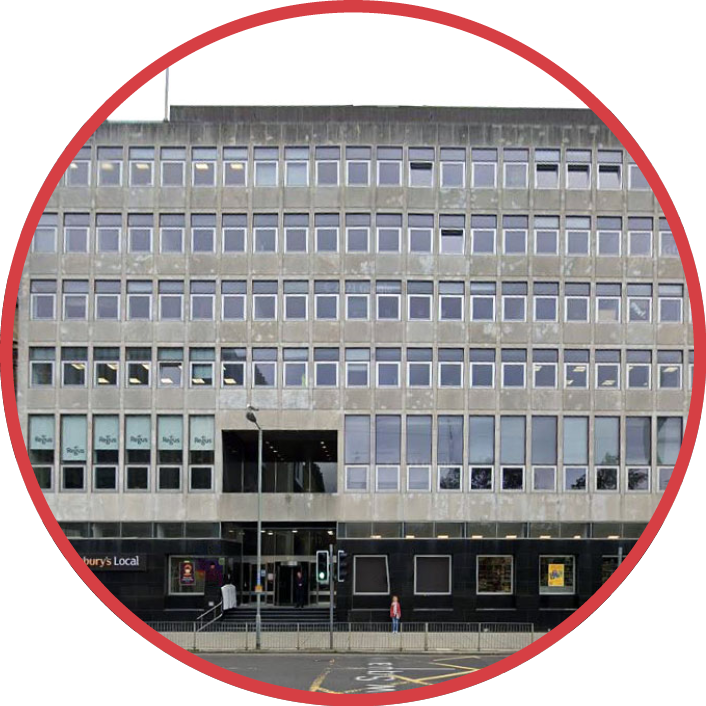
“Cheers to a New Year and another chance for us to get it right…!”
– Oprah Winfrey
At a macro-level, it feels like there wasn’t a lot “right” either economically or geo-politically for the year just passed and for many in the investment market, the end of 2023 could not come quick enough. However, we don’t subscribe to the adage of “survive till ‘25”, we are more in the camp of “get in the door in ‘24”…
The perfect storm of lack of confidence, rising cost of debt and a disconnect between seller’s and buyer’s aspirations made it a tough year but there are some signs of improvement. To quote from a recent Goldman Sachs Report on the outlook for 2024 — “The Hard Part is Over”. While year-end volumes are 14% down on the 5-year average, the positives include a more settled lending environment, values more in line with reality and a weight of money waiting in the wings. Of course, there will be challenges to come but momentum is starting to build.
With this backdrop, rather than looking back over 2023, our focus in this review (in addition to our usual market analysis) will be looking forward to 2024. Will it be a year of opportunity, what sectors will fare best and what will be the key drivers for creating a more liquid market. To help form our view, we are pleased to include contributions from a banker, fund manager, investment manager and an overseas investor.
Another popular Oprah Winfrey quote is “When I look to the future, its so bright it burns my eyes…”. We might not yet have our sunglasses on but here’s to a brighter 2024…
Market Overview.
Key Themes
First Administrative Receiverships – after much pretending and extending, we are finally seeing some stock coming to the market, instructed by Receivers. Painful as this is likely to be for lender and borrower, it is a sign of progress in the cycle and those over-leveraged borrowers (particularly with development opportunities) are having their arms forced to sell.
Proper price discovery – recent transactions (particularly in the sector most under pressure – offices) are giving a benchmark for how far the market has moved and what sort of pricing will be required to peek investor interest. While it is not uniform across the sectors, it does highlight the continued theme of “risk-off” for most.
Size isn’t everything – not what most agents want to hear but the most liquid part of the market remains sub £10m. Private buyers with limited or no debt requirements are seeing the current market as ripe for picking up core plus assets, properly re-priced. Particularly active are the Northern Irish investors who, for several reasons, not least geographically, have always seen Scotland as a happy hunting ground.
Cost of money stabilising – after a turbulent period, there are some signs that the cost of debt is starting to ease. In the summer of 2023, 5-year swaps were hovering around 5.5%, they are now c3.9%. Small steps but heading in the right direction. This won’t be the catalyst for a wave of new lending but will, at least, give some confidence to lenders and start to make debt accretive for better assets.
Now is the time – for those well capitalised with limited legacy issues to be picking up prime/core-plus assets. Opportunistic buyers are already active, taking advantage of a market where the buying playing field is not crowded. Once the tide turns the window may well start to close during the latter half of 2024.
Transaction Volumes
Q4 saw £382m traded down 4% on Q4 2022.
Q4 volumes were 14% below the 5 year average.
Total volumes for 2023 will end up close to £1.4bn, a decrease of 20% on the total for 2022. Not a surprising result given the wider macro-economic and geo-political headwinds.
No Data Found
Pricing
That feeling of “catching a falling knife” has dissipated and been replaced with a much more realistic view from sellers on where the market? actually lies. Valuers (who would want to be one in this market) have been hitting year-end values where they can, which is helping to bring more liquidity to Funds needing to sell. Investment Committees and Credit Committees remain particularly vigilant and any bidding on new product is generally erring on the side of caution.
Logistics and multi-let industrials remain stable and in the very best locations, showing signs of improvement. Our experience of selling a prime multi-let estate in South Gyle, Edinburgh has shown good appetite for the product and competitive bidding. Prime yields for logistics have stabilised at 5.75-6.00% and multi-let industrials at c6.25% but trending stronger.
Offices remains the hardest sector to call with a real divergence of opinion on future prosects and where true value lies. The lack of transactions tells you everything. The sale of several prime buildings in Glasgow has been slow and in Edinburgh, the sale of Edinburgh One (albeit a development opportunity) has shown the site value has more than halved from its peak. Our best guide on prime yields is in the mid-6%’s but it would have to be a special building at this level and, for anything but the best, the level would be 50 bps softer.
Retail warehousing looks like offering good value. For urban parks and those anchored by value occupiers, prime yields have softened to between 6.5-7% but for larger parks, eg:- Craigleith in Edinburgh (at £65m), pricing at c7.5% looks attractive. On the high street, again the limited number of transactions is telling but for the best product, well let, then 6.5% is being achieved.
In the Living sector, appetite remains robust, but the number of relevant transactions has been limited. Yields have slipped slightly as the effect of increased construction and market sentiment have finally had an effect. Yields of c5.00% for prime BTR and 5.25%-5.75% for prime PBSA are reasonably stable.
Buyer Activity
Fund activity remains selective and quite opportunistic. While the Living and Logistics sectors continue to be supported by research teams and Investment Committees, we are seeing other sectors including retail warehousing and leisure (with yield) coming into focus. Overall, we see them continuing to be net sellers but attractive pricing in some sectors is starting to catch their attention.
Core-plus buyers are starting to see some value in offices, leisure and retail warehousing where values have fallen to a level that debt can be accretive, c7.5%. Stock selection remains paramount, but it feels like the well-financed buyers in this space are starting to become more active.
The patience shown by opportunistic buyers looks like it will be rewarded in the not too distant future. While we do not anticipate a wave of forced selling, the new world of more expensive debt is here to stay for the foreseeable future which will start to loosen stock over the next 12 months.
Key Recent Transactions.
Q4 saw some interesting themes and significant transactions which we have highlighted below:

The Centre, Livingston
“One of Scotland’s largest shopping centres trades”
Vendor: Hines
Purchaser: M Core – Evolve Estates & LCP
Let to: Multi-let
Price: £45.50m
Date: December 2023

Kingsway West Retail Park, Dundee
“US investor strikes again”
Vendor: Ares Management Corporation
Purchaser: Realty Income Corporation
Let to: Multi-let
Price/Yield: £30m / 9.00%
Date: November 2023

South Gyle Trade Park, Edinburgh
“Private investor acquires prime leasehold multi-let industrial estate”
Vendor: abrdn
Purchaser: Private Investor
Let to: Multi-let
Price/Yield: £13.97m / 6.87%
Date: December 2023

9-10 St Andrew Square, Edinburgh
“Prime redevelopment opportunity snapped up by hotel operator”
Vendor: Patrizia
Purchaser: Queensway / Tristan Capital Partners
Let to: Regus & Sainsbury’s
Price: £20m
Date: November 2023
The investor view on the year ahead:
Will 2024 be a year of opportunity?
No Data Found
An overwhelming majority, 96%, believe 2024 will be a year of opportunity – here’s hoping!
Whilst 100% of funds, investment managers and private equity responded in the affirmative, it was noted by a number of respondents that the sluggish end to 2023 is expected to continue into H1 2024, with opportunistic buyers continuing to benefit from softer yields and thin buyer pools.
The only investor category providing a note of caution are property companies with 12% having a pessimistic outlook on the year ahead. With property companies being relatively active during 2023, perhaps they remain hamstrung by more challenging debt arrangements.
What will the top three performing sectors be in 2024?
No Data Found
The three top performing sectors are expected to be Living, Industrial and Retail Warehousing, with these sectors accounting for 92% of responses, with the office and high street retail sectors representing just 2% and 6% of responses respectively.
These sectors have been at the top of many requirement lists over the last 2 years, with the Living sector and in particular PBSA being a standout performer, with investors continuing to find the demand/supply imbalance in key cities a compelling prospect.
The office sector continues to be the hardest to appraise, with a lack of transactional activity over the last 18 months and rising capex to meet sustainability requirements, leading to pricing uncertainty. The high street retail sector remains out of vogue, however it was noted that in the very best locations where there is genuine rental growth prospects (off properly re-based rents) then historically soft yields are starting to appear attractive.
What three factors do you see as creating a more liquid market in 2024?
No Data Found
The three factors most commonly picked by respondents were ‘Improving macro-economic conditions’ (24%), ‘Debt terms stabilising/improving’ (23%) and ‘Confidence’ (21%).
Only 2% view a new UK Government as increasing liquidity, however the lead up to any election tends to see subdued transactional activity, hopefully an early 2024 election will lead to some political stability!
There is anticipation of debt backed investors finding their feet, with the Bank of England widely predicted to begin gradual cutting of interest rates from mid-2024, this coupled with the first signs of proper repricing in the market gives cause for optimism heading into the new year.
“Expert view” on the outlook for 2024…

Miles Skinner
Head of Investment Management UK & Ireland
Union Investment Real Estate GmbH
2024 – year of opportunity?
After the significant challenges faced during the course of 2023, we all very much hope so! While there seems to be a greater sense of confidence and clarity around the possible trajectory of interest rates, the wider capital markets remain dysfunctional and it will take time for this sentiment to dissipate. I expect the start of 2024 to remain challenging, however as 2024 progresses there should be greater opportunities to buy in what will be a price-corrected market.
Sectors in favour?
Our funds have the ability to invest in a number of different sectors where we can achieve appropriate risk-adjusted and performance enhancing returns. We continue to have high conviction in best-in-class, ESG compliant, future-proofed offices alongside our other strategies focused on the traditional sectors being residential, hotel, logistics and retail.
What factors do you see as creating a more liquid market in 2024?
The consensus view is that interest rates will start to come down in 2024 but whether this will be as early as Q2 or later in the year will be important to assess. This will create a more favourable lending environment which should ease liquidity pressures on investors seeking to deploy into the real estate markets.

Oli Lord
Head of UK Transactions
abrdn
2024 – year of opportunity?
A game of two halves with possibly a muted first half as interest rates remain where they are, and investors wait to get more comfortable once there are clear signs that cuts will occur. The volatility in swap rates, which fed through into financing costs during 2023 and concerns that inflation was proving to be stickier than anticipated by the market, seemed to cause uncertainty and there was little clarity on how rates would pan out. This held investors back or resulted in price adjustments as investors return requirements changed but also failed marketing campaigns. However, there is a general view that rates will start falling in H2 2024, with the market currently pricing in 100bps of rate cuts in 2024.
Sectors in favour?
With the industrial development tap having largely been turned off due to rising build costs and outward yield shift, the industrial market remains attractive from a rental growth story. Similarly in the retail warehouse market, there appears to be an attractive occupational story with vacancy rates below 5% and the sector offers relatively higher yields against good covenants and the prospect of underlying rental growth due to low vacancy rates and good demand. The residential sector continues to look interesting from a rental growth story and with some housebuilders looking to raise cash for their pipeline whilst debt costs remain relatively high.
What factors do you see as creating a more liquid market in 2024?
For me, the most important factor is that once there are clear indications that the cutting cycle will start, it should provide more confidence and clarity on the direction of travel and importantly the gap that has existed between vendor and purchaser’s aspirations and been a real liquidity issue in 2023 should close / reduce and so increase liquidity. This year should be the year of increasing investor confidence and an improving lending market and a movement back towards debt becoming accretive, all of which will improve liquidity.

Jamie Drummond
Director, Real Estate Finance
Royal Bank of Scotland
2024 – year of opportunity?
Very much so. Transactional activity has really picked up and I expect that to build further through 2024.
Sectors in favour?
It’s all about quality assets which are already carbon efficient or can be economically repositioned. I’m seeing development opportunities across all sectors as inflation and the outlook for interest rates abate. Logistics, Student, Retail, and Office are key sectors at the moment and also Leisure and Residential including BTR.
What factors do you see as creating a more liquid market in 2024?
Rates and inflation are key in attracting liquidity back into the market and also the economic landscape which remains tricky but should be helped by new liquidity.

Derek Heathwood
Managing Director
4th Industrial LP
2024 – year of opportunity?
Perhaps. In the industrial world there has been a lack of stock which will only be solved if yields come in, making sales profitable, or owners are forced to sell if they have liquidity or debt issues. Many observers regard ’23 as a low point in the market from a capital perspective but continued rental growth has allowed industrial owners to service debt yields and ride it out. Unless you have a compelling reason to sell you will hold on, especially as all the indications are that interest rates will continue to fall and the current data suggesting a low point during 2025. I have a sense, however, that there will be opportunities of scale for well capitalised businesses that can move quickly towards the end of ’24 but it won’t be for the faint-hearted.
Sectors in favour?
I am biased but multi let / mid box industrials that tick the ESG / EPC boxes in the correct UK sub-markets with near term lease events, should always be in favour. Any other sector that is experiencing rental growth, healthy occupier demand and isn’t capex hungry are the ones that will outperform the market.
What factors do you see as creating a more liquid market in 2024?
Inflation staying on the current path and the knock-on effect on interest rates will be a key driver. Those with liquidity and debt issues will make up the bulk of the sellers during the year but I’m not sure it will open the flood gates. I hope I am proved wrong.
“Our view”on the outlook for 2024…
Pressured sellers creating opportunity
Whilst there was relatively limited distress during 2023, the tail end of the year saw some a number of sales driven through unviable refinancing and the effect of rising costs on developments which no longer made sense. For investors who have built up substantial reserves of dry powder, there are sure to be opportunities in the coming months.
Sectors offering best value
Retail – in particular retail warehousing and grocery anchored retail.
Edinburgh offices – several late 2023 deals have re-set the market in terms of pricing. Core-plus assets offering close to double digit yields look attractive.
Multi-let industrials – in the central belt. The demand/supply dynamic remains compelling.
Rental growth the focus
With a lack of development and robust occupier demand, we expect rental growth to underpin investor rationale in the retail warehousing, industrial and high street retail sectors. Rental growth is also likely to drive selective investor interest in office markets which have rebounded strongly post pandemic, such as Edinburgh, where the supply and pipeline of Grade A space is minimal and floor space continues to be lost to alternative uses. Prime rents will continue to grow for best in class city centre buildings with strong ESG credentials.
Importance of ESG
Investors are increasingly conscious of ESG credentials of assets on a cross sector basis and the divergence in pricing between those buildings/developments which have best in class sustainability and those which require substantial capex going forward is likely to become more pronounced. High capex costs on office refurbishment projects are likely to require office values to soften further to make projects ‘stack up’.
After a subdued 2023, PBSA activity to return
The appetite for PBSA in the strongest locations shows no sign of diminishing, with supply/demand dynamics ensuring strong rental growth forecasts and a good depth from buyers for both up and built stock and fundings.